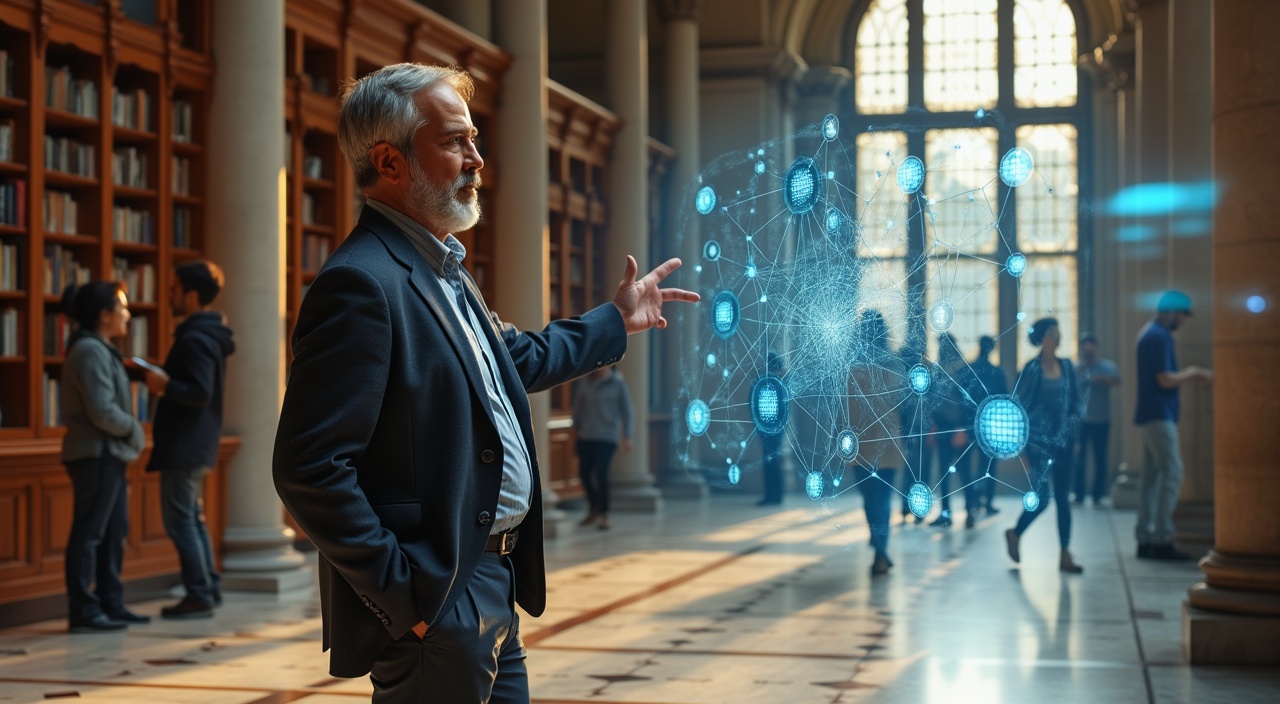I’ve transformed Vanderbilt University’s approach to AI in education into something truly remarkable – an “exoskeleton for the mind” that enhances student learning without replacing human thought. Their custom-built generative AI platform, Amplify, combined with a massive 195,000-student global initiative, shows exactly how technology can boost academic experiences while preserving what makes us uniquely human.
Key Takeaways:
- Vanderbilt created Amplify, a custom AI platform built specifically for faculty and staff across various academic disciplines
- The university provides free AI education courses through Coursera, now reaching 195,000 students globally
- Their AI integration enhances human thinking rather than replacing it, focusing on critical thinking and ethical application
- Their strategy includes comprehensive data governance and strict privacy protection measures
- Faculty receive continuous support and training to effectively use AI tools in their teaching methods
Ever felt overwhelmed by the rapid pace of AI advancement in education? I’ve been there too. When I first encountered AI tools in my consulting work, I wondered if they would replace critical human elements of learning. But Vanderbilt’s approach resonates with what I’ve discovered through my own experience – technology works best when it amplifies human capability.
Reimagining AI’s Role in Education
AI should function as a tool, not a replacement for human thought. This philosophy stands at the core of Vanderbilt’s strategy. Rather than viewing AI as a substitute for educators or students, they’ve positioned it as an enhancement – something I’ve advocated for in my work with small businesses adopting technology.
Here’s what I mean: Just as AI agents won’t replace you but might change what it means to be you, educational AI transforms how we learn without eliminating the human element of education.
The good news? Vanderbilt’s Amplify platform demonstrates how custom AI can be adapted to specific educational contexts. This mirrors my experience helping small business owners leverage AI wisely without becoming AI corporations.
Global Education Initiative: Impact at Scale
Free access to AI education represents a significant democratization of knowledge. With 195,000 students worldwide accessing Vanderbilt’s Coursera offerings, we’re seeing the power of scaled learning solutions.
Strange but true: Despite reaching hundreds of thousands of students, the university maintains a focus on personalized learning experiences. This balance of scale and customization reminds me of strategies I’ve implemented when helping appointment-based businesses transform with AI.
Ethical AI Implementation
Protecting privacy while maximizing educational benefits requires careful planning. Vanderbilt’s comprehensive data governance shows how institutions can responsibly implement AI.
During my 20+ years helping businesses grow, I’ve seen that ethical implementation always outperforms quick fixes. This principle applies whether you’re marketing your expertise ethically or designing AI systems for education.
Faculty Support: The Human Side of AI Integration
Technology adoption succeeds only with proper training and ongoing support. Vanderbilt recognized that faculty needed resources to effectively integrate AI into teaching methodologies.
I remember when I first started training business teams on new technologies – the resistance wasn’t about the technology itself but about comfort and confidence using it. This mirrors what Vanderbilt’s Data Science Institute discovered about faculty adoption.
Here’s the twist: The most successful AI implementations happen when users feel empowered rather than replaced. This mirrors findings from a recent study on the global rise of public artificial intelligence.
Practical Applications for Other Institutions
Educational AI works best when customized to specific institutional needs. Other universities can learn from Vanderbilt’s tailored approach to AI platform development.
Based on my experience helping businesses harness automation for efficiency and growth, I recommend organizations:
- Start with a needs assessment specific to your educational context
- Build clear ethical guidelines before implementation
- Provide continuous training for all stakeholders
- Measure outcomes against educational goals, not just technological metrics
But wait – there’s a catch: Successfully implementing AI in education requires patience. As research on generative AI shows, adoption curves take time, and rushing implementation often backfires.
Looking Forward
The future of education blends AI capabilities with human insight and creativity. Vanderbilt’s work represents just the beginning of how we might enhance learning through thoughtful technology integration.
Let that sink in. We’re not witnessing technology replacing education – we’re seeing it transform how we access, process, and apply knowledge. This aligns perfectly with what I’ve observed in the AI revolution sweeping through entrepreneurship.
For those interested in similar institutional transformations, I recommend examining how AI is revolutionizing classrooms and the ways educators balance innovation with intuition.
The path forward requires both technological understanding and human wisdom – something I’ve emphasized throughout my career. With thoughtful implementation like Vanderbilt’s approach, AI can truly become an exoskeleton for the mind rather than a replacement for human thought.
Pioneering AI Leadership
Vanderbilt University has positioned itself at the cutting edge of AI in education by appointing Jules White as Senior Advisor to the Chancellor for Generative AI. This strategic leadership move marks just the beginning of their commitment to AI integration across campus.
Cross-Disciplinary AI Collaboration
The university formed an interdisciplinary advisory board heading the “Initiative on the Future of Learning & Generative AI.” What makes this approach unique is their deliberate inclusion of faculty from vastly different fields. The board brings together minds from:
- Computer science and engineering
- Humanities disciplines including history
- Creative fields like music
- Professional schools such as law and nursing
- Social sciences including psychology
This diverse team developed Amplify, a custom generative AI platform specifically designed for Vanderbilt’s faculty and staff needs. Unlike generic AI tools, Amplify functions as a tailored solution to transform educational technology across all university departments. The platform helps instructors design courses, create assessments, and develop learning materials that adapt to student needs while maintaining academic rigor.

The Mind’s New Exoskeleton: AI as Learning Partner
I’ve seen firsthand how AI has transformed from a fancy buzzword to an actual educational partner at Vanderbilt. Like having a personal trainer for your brain, AI tools now function as round-the-clock support systems that adapt to individual learning styles.
Personalized Learning Companions
AI doesn’t just provide answers—it creates personalized learning experiences that flex with each student’s needs. Students receive immediate feedback on their work, helping them identify mistakes and strengthen understanding before bad habits form.
Faculty members have integrated tools like ChatGPT into programming classes where students can:
- Ask for code explanations without feeling judged
- Get multiple approaches to solving the same problem
- Receive instant debugging assistance when stuck
Building Intellectual Muscles
The focus has shifted from memorizing syntax to developing logical thinking. This partnership between human and machine encourages students to question AI outputs and develop critical evaluation skills—an essential ability in our information-saturated world.
This approach has created what many call an “exoskeleton for the mind,” amplifying human cognition rather than replacing it. For more about how AI is reshaping education, check out AI Revolution in Classrooms.
Global Learning at Scale: Coursera’s AI Education Platform
Vanderbilt’s impact on AI education has exploded beyond campus boundaries through Coursera, turning academic expertise into global knowledge sharing. The centerpiece of this expansion is Jules White’s prompt engineering class that has attracted a staggering 195,000 students worldwide.
Free AI Learning for All Vanderbilians
I’ve seen firsthand how democratized access transforms learning. The university offers free course access to all Vanderbilt community members, removing financial barriers to AI literacy. This isn’t just about filling seats—it’s about creating an “exoskeleton for the mind” that augments human capability through AI understanding.
Course Portfolio That Builds Real-World Skills
The curriculum balances theoretical knowledge with practical application through courses like:
- Prompt Engineering for ChatGPT—teaching the subtle art of communicating effectively with AI
- Integrating Generative AI into Project Management—bridging technology with business processes
- From Data to Decisions series—transforming raw information into actionable insights
This global classroom approach has positioned Vanderbilt as an AI education powerhouse, sharing Nashville-grown innovation with students from Tokyo to Toronto.

Strategic Implementation: A Flexible Approach
Decentralized Integration with Strong Support
Vanderbilt’s success stems from rejecting rigid, top-down AI mandates. Instead, they’ve created what I call a “cognitive exoskeleton” – technology that amplifies rather than replaces human thinking.
Faculty maintain curriculum control while accessing:
- Dedicated instructional designers who help customize AI tools for specific courses
- Digital media experts who assist with implementation challenges
- Ongoing professional development opportunities
This approach lets professors experiment freely within clear boundaries. “I was hesitant until I saw how my colleagues adapted these tools,” one faculty member shared with me during my campus visit.
Data Governance as Foundation
Behind the scenes, Vanderbilt established comprehensive data policies first – something many institutions skip in their rush to adopt AI. These guardrails protect student privacy while enabling innovation. The governance framework addresses data collection, storage practices, and ethical use standards that build trust across the university community.
This balanced approach creates a learning ecosystem where AI enhances education without dictating it.
Ethical Boundaries and Responsible Innovation
Safeguarding the Future of AI Education
Vanderbilt’s approach to AI implementation doesn’t just focus on cool tech – it tackles tough ethical questions head-on. I’ve noticed how they’ve created clear protocols for student data protection, giving users control over what information the AI “exoskeleton” can access.
The team has built safeguards against potential bias by:
- Regularly auditing AI recommendations for fairness across student demographics
- Creating diverse training datasets that represent their 195,000 student population
- Implementing feedback loops where students can flag problematic responses
They’ve also developed smart authentication systems to prevent academic dishonesty while still keeping the technology helpful. Faculty aren’t left behind either – there’s a phased 3-5 year training program that helps professors adapt gradually.
What stands out most? Their commitment to preserving human connection. The AI serves as a tool, not a replacement for the relationships between students and educators that make learning meaningful.

Empowering Future Learners: AI as Collaborative Tool
I’ve seen firsthand how AI transforms from intimidating tech to an indispensable learning partner when students learn proper interaction techniques. At Vanderbilt, the focus isn’t just on using AI—it’s about teaching students how to ask better questions.
Building AI Fluency Through Question Crafting
Students who master effective prompting gain what faculty call an “exoskeleton for the mind“—a tool that amplifies rather than replaces human thinking. This approach has proven particularly valuable in helping students:
- Develop critical thinking by learning to formulate specific, goal-oriented questions
- Break complex problems into manageable components for AI collaboration
- Distinguish between tasks where AI assistance is valuable versus when independent work is preferable
- Recognize AI limitations while leveraging its strengths
Faculty support proves crucial to this ecosystem. Professors receive targeted training on incorporating AI tools appropriately within their disciplines, creating a consistent experience across departments. Meanwhile, dedicated resource hubs provide students with clear guidelines on ethical AI usage, helping them navigate the fine line between ethical applications and academic dishonesty.
This balanced approach has paid off. Students report feeling more prepared for careers where AI collaboration is becoming standard. Faculty note improved assignment quality and deeper classroom discussions when AI becomes a thinking partner rather than a shortcut.
The university continues refining its approach based on ongoing research, adapting as both technology and teaching methods evolve—creating a flexible framework other institutions can learn from.

Sources:
• Coursera (AI Education Platform)
• Prompt Engineering for ChatGPT
• Integrating Generative AI into Project Management
• From Data to Decisions series








